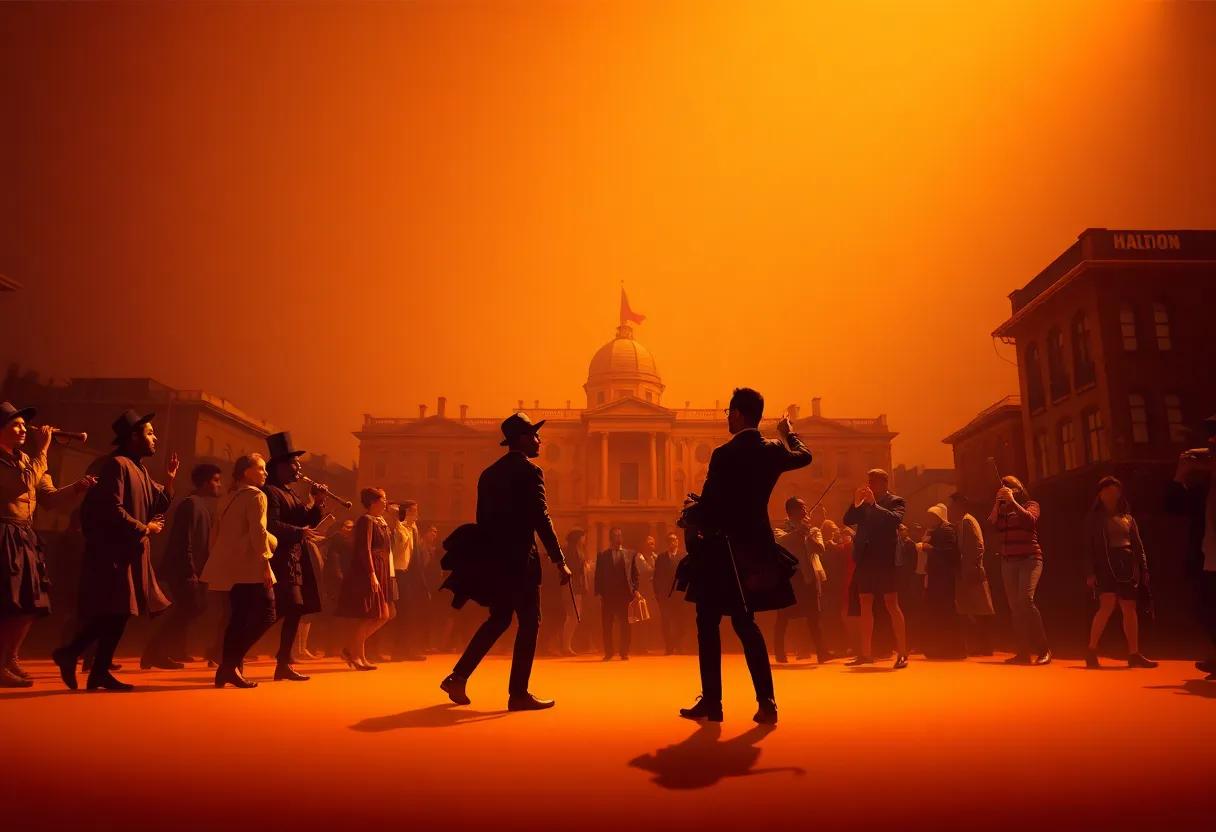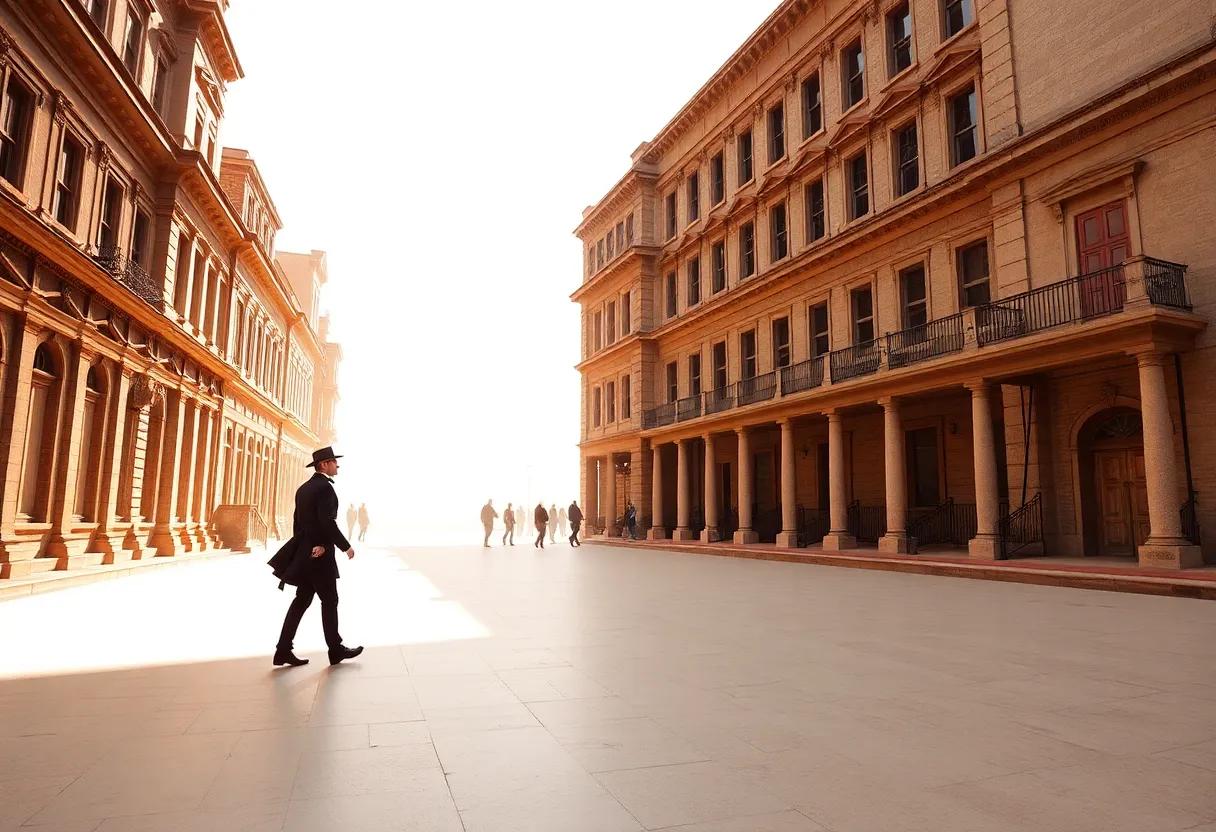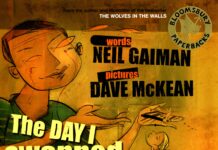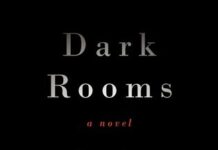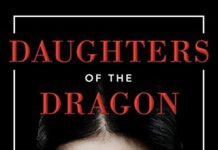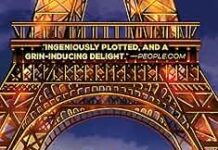In the ever-evolving landscape of musical theatre, few works have sparked as much conversation and admiration as Lin-Manuel Miranda’s Hamilton. With its innovative melding of hip-hop, history, and heartfelt storytelling, the production has not only reinvented a genre but also redefined cultural narratives. Unpacking Genius: A Closer Look at Hamilton: The revolution by Miranda invites readers behind the curtain, offering a thoughtful exploration of the creative forces shaping this groundbreaking work. This review delves into how the book navigates the complexities of Miranda’s vision, the collaborative artistry involved, and the broader importance of Hamilton in contemporary art and society.
Exploring the Intricate collaboration Behind Hamilton The Revolution and Its Impact on Modern Theater Appreciation
Behind the groundbreaking success of Hamilton: The Revolution lies a meticulously orchestrated partnership between Lin-Manuel Miranda and director Thomas Kail. This collaboration weaves together music, history, and storytelling in a way rarely seen on stage before. Miranda’s visionary writing and composition meld seamlessly with Kail’s dynamic direction, creating a tapestry that both revitalizes American history and modernizes musical theater. Adding to the richness, choreographer Andy Blankenbuehler’s innovative movement vocabulary bridges conventional Broadway styles with hip-hop culture, pushing the boundaries of stagecraft and audience engagement.
The impact on modern theater appreciation is profound; this intricate creative synergy invites audiences to rethink the ways stories are told through musicals. It encourages theaters worldwide to embrace diverse narratives and experimental approaches. At its core, the collaboration champions inclusivity-not just in casting but in musical genres and storytelling methods. here’s how the core creative roles contributed uniquely to this renaissance:
- Lin-Manuel Miranda: Composer, lyricist, and book writer who crafted a multi-genre score blending hip-hop, R&B, and traditional show tunes.
- Thomas Kail: Director whose vision sharpened the storytelling and pacing, ensuring the narrative’s momentum remained relentless.
- Andy Blankenbuehler: Choreographer whose innovative movement vocabulary energized the production’s visual language.
- Alex Lacamoire: Musical arranger and orchestrator who transformed complex compositions into seamless theater pieces.
| Role | contribution | Impact |
|---|---|---|
| Composer/Lyricist | Inventive score blending genres | Redefined musical theater soundscape |
| Director | Dynamic storytelling approach | Heightened emotional engagement |
| Choreographer | Modern, kinetic movement style | bridged cultural rhythms with classic form |
| Orchestrator | Layered intricate arrangements | Enhanced musical complexity |
A Deep Dive into the Annotated Lyrics That Reveal Lin Manuel mirandas Creative Genius and Historical Storytelling
Lin-Manuel Miranda’s annotated lyrics transcend mere words on a page; thay unlock layers of history, emotion, and intricate wordplay that define Hamilton as a groundbreaking musical. Each line serves as a miniature story within the larger narrative, revealing Miranda’s masterful ability to intertwine contemporary rap with the complex lives of founding fathers. His annotations offer readers a privileged glimpse into his creative process – how a single phrase might reflect historical context, personal ambition, or political undertones. This meticulous attention to detail transforms lyrics into vibrant, multidimensional artifacts that engage both theater lovers and history enthusiasts alike.
What emerges from thes insights is not only a testament to Miranda’s storytelling prowess but also a party of the american spirit, seen through a modern lens.Key themes are repeatedly emphasized through clever callbacks and reinterpretations, illustrating the musical’s layered construction.A fast look at some central motifs highlights this:
- Legacy and Memory: Lines often reference historical legacies while challenging how we remember the past.
- Ambition and Identity: The struggle between personal goals and public persona drives much of the lyrical tension.
- Revolution as Dialog: Dialogue and lyricism serve as revolutionary acts, reshaping history through narrative.
| Lyric Example | Annotated Insight | Historical Reference |
|---|---|---|
| “I am not throwing away my shot” | Symbolizes Hamilton’s relentless ambition and risk-taking | Hamilton’s rise from obscurity to power |
| “Raise a glass to freedom” | Reflects celebration of revolutionary ideals | End of British rule and birth of a new nation |
| “who lives, who dies, who tells your story?” | Questions legacy and the control of historical narrative | Historical memory and narrative control |
Behind the Scenes Insights Into the Set Design Costumes and Visual Aesthetic that Bring Hamilton to vibrant Life
The magic of Hamilton doesn’t rest solely on the powerhouse lyrics or the riveting performances; it lives palpably in the meticulously crafted world that the set and costume designers create. Every element is a deliberate brushstroke on the vibrant canvas that tells Alexander hamilton’s story through a modern lens. The industrial scaffolding and rotating turntables transform the stage into a dynamic, living organism, evoking the relentless motion of a young nation in flux. These choices invite audiences to feel both the chaos and the beauty of revolution, with every metallic beam and shadowed corner serving as a metaphor for the unsteady foundations of democracy.
Costumes, meanwhile, merge period authenticity with contemporary flair, incorporating layers that reflect characters’ transformations and social statuses-think military jackets trimmed with sharp tailoring and textured fabrics that balance historical fidelity with theatrical boldness. Below is a glimpse into some key costume elements and their symbolic meanings:
| Costume Element | Character | Symbolic Significance |
|---|---|---|
| Dark Overcoat with Epaulettes | Alexander Hamilton | Ambition and discipline, the weight of leadership |
| Rich Velvet Waistcoat | Marquis de Lafayette | Elegance and rebellion |
| Flowing Gown with Bold Colors | Angelica Schuyler | strength, intelligence, and vibrance |
| Leather Boots | All Male Leads | Grounded determination and resilience |
Analyzing the Musical Fusion of Hip Hop Jazz R and B and Traditional Broadway Soundtracks in the Show’s Score
The soundtrack of Hamilton is a groundbreaking tapestry where hip hop’s rhythmic intensity dances seamlessly with the soulful melodies of jazz and R&B, all while honoring the grand traditions of Broadway. This ingenious fusion transforms historical storytelling into a vivid,contemporary experience. the aggressive wordplay and rapid-fire delivery borrowed from hip hop serve as a vessel for the show’s dynamic narrative drive, while jazz improvisations and R&B’s emotional depth add layers of texture and feeling. Together,these genres create a soundscape that is at once innovative and familiar,bridging centuries and cultures in each note.
What truly sets the score apart is how these diverse influences are woven with the narrative structure and musical motifs typical of classical theater. Consider the way choruses evoke traditional Broadway ensemble numbers, yet propelled by hip hop’s beatbox rhythms and syncopated jazz phrasing. The following table illustrates a brief breakdown of key elements contributed by each genre to the overall sound:
| Genre | Musical Characteristics | Narrative Role |
|---|---|---|
| Hip Hop | Rapid rhythms, lyrical flow, percussive delivery | Expresses urgency, conflict, and personal ambition |
| Jazz & R&B | Smooth harmonies, improvisational elements, soulful vocals | Adds emotional nuance and introspection |
| Traditional Broadway | Structured melodies, orchestrated ensembles, leitmotifs | Provides dramatic cohesion and theatrical grandeur |
- Layered storytelling: The hybrid score supports complex character arcs with musical contrasts.
- Cultural dialogue: It pioneers a conversation between contemporary urban culture and timeless theatrical traditions.
- Innovative energy: The seamless blending elevates every scene, turning dialogue into lyrical poetry and history into living art.
how Hamilton The Revolution Captures the spirit of Revolution and Reinvents American History for a New Generation
Hamilton: The Revolution serves as more than just a behind-the-scenes look at the creative process of Lin-Manuel Miranda’s groundbreaking musical; it is a cultural manifesto that reimagines history through a vibrant, contemporary lens. By blending hip-hop, R&B, and traditional Broadway styles, the work bridges the gap between the 18th century and present-day America, making the revolutionary spirit accessible and relatable to a diverse audience. The book delves deep into the characters’ motivations and the socio-political upheavals of the time, illuminating how the ideals of liberty, resilience, and ambition resonate just as powerfully today. Miranda’s lyrical genius, paired with historical insights, invites readers to reconsider the founding fathers not as distant figures but as dynamic, flawed humans who shaped a nation-and whose legacies continue to evolve.
- revolution as Narrative: The text reframes American history as a living story rather than a static past.
- Musical Innovation: Explores the fusion of modern music with historical storytelling.
- Diverse Perspectives: Highlights marginalized voices through casting choices and lyrics.
| element | Historical Impact | modern Interpretation |
|---|---|---|
| Lyrics | Tell revolutionary stories | Blend of hip-hop and Broadway styles |
| Characters | Founding fathers and contemporaries | Complex, humanized portrayals |
| Storytelling | Chronicles America’s founding | Highlights themes of struggle and perseverance |
By reinventing history for a new generation, Hamilton: the Revolution challenges traditional narratives to emphasize that the story of America is not fixed but ever-evolving. It champions the idea that revolution is ongoing-not just in political terms but in cultural and artistic expression as well. this narrative device compels readers to engage critically with the past while recognizing the power of storytelling to shape the future, making history not only a lesson but also an inspiration.
The Role of Fan Engagement and Community building in Amplifying Hamilton’s Cultural Phenomenon and Longlasting Legacy
at the core of Hamilton‘s unprecedented cultural impact lies an intensely dedicated fan base that transcends traditional theater audiences. The show’s ability to spark conversations about history,identity,and social justice has cultivated a sprawling community of enthusiasts who actively engage beyond the stage. This vibrant network thrives on shared experiences-from opening night reactions on social media to fan art, deep-dive analyses, and interactive events. By fostering a space where fans can connect, interpret, and celebrate the musical’s narrative, the creators empowered audiences to become co-creators in preserving and amplifying its cultural resonance.
Community building also materializes through organized initiatives that extend Hamilton‘s reach, such as educational workshops and digital forums.These efforts reinforce the musical’s legacy by embedding it in collective memory while inviting fresh voices to reinterpret its themes. Below is a snapshot of key fan engagement avenues that have played crucial roles in elevating the musical’s presence:
- Social Media Campaigns: Viral hashtags and fan challenges that generate global buzz
- Interactive fan Events: Virtual town halls, cast Q&As, and listening parties
- Creative Collaborations: Fan-made videos, mashups, and artwork celebrating the show’s characters and messages
- Educational Outreach: Curricular materials and partnerships with schools to teach history through Hamilton’s lens
| Engagement Type | Impact | Audience Reach |
|---|---|---|
| Social Media | Massive viral sharing and cultural conversations | Millions worldwide |
| Fan Events | Deepened emotional connection and accessibility | Thousands per event |
| Creative Content | Expanded narrative through diverse perspectives | Tens of thousands |
| Educational Programs | Legacy cemented in academic discourse | Hundreds of schools |
Uncovering the Symbolism and Thematic Undercurrents that Weave Through the Script and Production elements
Lin-Manuel Miranda’s Hamilton: The Revolution is much more than a historical retelling-it’s a layered tapestry where symbolism pulses through every lyric, staging choice, and musical motif. The script leverages language as both weapon and shield, weaving modern vernacular with classical allusions to underscore themes of legacy, ambition, and identity. For instance, the recurring motif of writing letters and “papers” symbolizes not only the literal creation of history but also the power to shape narrative and memory. This duality is echoed visually through the fluid set design, where movable scaffolding mirrors both the dynamism of revolution and the precariousness of Hamilton’s ascent.
The production’s thematic undercurrents are equally rich, with light and shadow choreographed to emphasize moral ambiguity and the blurred lines between heroism and hubris. Consider this breakdown of symbolic elements and their thematic resonance:
| Symbolic element | Thematic Significance |
|---|---|
| Triangular Set Pieces | Fragmentation and unity of emerging America |
| Color Palette (Red & Gold) | Passion, power, and the cost of ambition |
| Rap Battles | Modern conflict and historical political discourse |
| Recurring Motif of Time | Mortality and urgency of legacy-making |
- Language as a living archive – capturing the revolutionary spirit through contemporary rhythms.
- Physical staging as metaphor - reflecting personal and political upheaval through dynamic movement and space.
- Musical hybridity – blending hip-hop, R&B, and traditional show tunes to highlight cultural evolution.
Why Readers of Hamilton The Revolution Will Benefit from the Detailed Essays and Historical Context Provided
The detailed essays in Hamilton: The Revolution serve as a vital bridge between the musical’s electrifying performances and the rich, often complex, history it draws upon. Readers are invited to explore the nuanced layers behind Alexander Hamilton’s story, moving beyond the stage to understand the sociopolitical dynamics of the era. This thoughtful context enriches the listener’s appreciation of Lin-Manuel Miranda’s genius, revealing how historical facts and creative liberties were carefully woven together to bring the American founding era to life in a way that resonates today.
Beyond mere background, the essays offer unique insights that stimulate critical engagement through:
- Character motivations: Understanding figures like Hamilton, Burr, and Jefferson beyond their famous quotes and conflicts.
- Musical inspirations: Connections between the hip-hop and Broadway styles that shape the musical’s distinctive voice.
- Historical accuracy versus artistic interpretation: A frank look at where the show stays true to facts and where it embraces storytelling.
| Essay Focus | key benefit for Readers |
|---|---|
| Political Context | Clarifies the stakes behind the Revolution’s debates |
| Music and lyrics Analysis | Deepens appreciation for Miranda’s creative choices |
| Cultural Impact | Explores the show’s relevance in modern social discourse |
A Closer Look at the Outstanding Photography That Chronicles the Energy and Emotion of Hamilton’s original Cast
The photography featured in Hamilton: The Revolution serves as a powerful visual narrative, capturing the raw intensity and nuanced emotion that defines the original cast’s performances.Through a masterful interplay of light and shadow, each image pulls viewers into the charged atmosphere of the stage, immortalizing moments that seem to vibrate with life. Whether it’s the fierce determination in Lin-Manuel Miranda’s eyes or the tender connection between characters during a poignant scene, the photos go beyond mere documentation – they become windows into the heartbeat of the production.
These photographs aren’t just static captures; they tell a dynamic story through details worth highlighting:
- Expressive Gestures: Every gesture, from clenched fists to outstretched arms, conveys volumes without words.
- costume and Design Harmony: The vibrant costumes and set designs amplify the storytelling, creating an immersive canvas.
- Cast Chemistry: The interplay between actors,visible in candid backstage shots and also onstage,reflects genuine camaraderie and collaborative spirit.
| Photographic Element | Impact |
|---|---|
| Close-ups | Highlight subtle emotional shifts |
| Wide Shots | Showcase ensemble energy and choreography |
| Backstage Moments | Reveal candid humanity behind the scenes |
How This Book Serves as an Essential Companion for Theater Practitioners Scholars and Musical Enthusiasts Alike
Hamilton: The Revolution offers an immersive dive into the creative alchemy behind one of the most groundbreaking musicals of our time. Theater practitioners will find an invaluable roadmap within its pages-unpacking the collaborative process, from Lin-Manuel Miranda’s initial spark of inspiration to the meticulous scriptwriting, choreography, and musical arrangement. The book serves as both a masterclass in artistic innovation and a practical guide, revealing how vision and execution converge to redefine theatrical storytelling. It emphasizes not only the mechanics of production but also the emotional intelligence required to bring history to vivid life on stage.
For scholars and musical enthusiasts, this companion piece transcends typical behind-the-scenes chronicles by contextualizing the cultural, historical, and social reverberations of the show. Readers are invited to explore:
- The fusion of hip-hop and traditional musical theatre styles
- Innovative narrative techniques that challenge conventional biographical storytelling
- The impact of representation and diversity in modern theatre
This rich tapestry makes the book an essential resource, bridging artistic practice and academic inquiry with inspiring accessibility.
Recommendations for incorporating Hamilton The revolution Into Educational Curricula and Creative Workshops
Integrating Hamilton: The Revolution into classrooms and creative workshops offers a dynamic way to explore literature, history, and the art of storytelling. Educators can leverage the book’s rich blend of *historical annotation* and *behind-the-scenes insight* to ignite students’ curiosity about the american Revolution through a contemporary lens.Encouraging students to analyze Lin-Manuel Miranda’s lyrical choices alongside the annotated lyrics fosters critical thinking and deepens understanding of how language shapes narrative and character advancement. Consider incorporating group discussions, creative writing assignments, and theatrical performances to bridge textual analysis with expressive creativity.
Workshops can further harness the book’s collaborative spirit,using it as a blueprint for empowering participants to craft their own stories or historical narratives with a modern twist. Interactive activities like improvisation sessions, songwriting clinics, and peer feedback groups can mirror Miranda’s process, demonstrating how layering research, rhythm, and emotion brings history to vivid life. Below is a concise table outlining potential workshop elements and educational benefits:
| Workshop Element | Educational Benefit |
|---|---|
| lyric Deconstruction | Enhances literary analysis and vocabulary skills |
| historical Context Mapping | Connects narrative to factual history |
| Collaborative Storytelling | Builds teamwork and narrative synthesis |
| Performance Practice | Develops confidence and interpretive skills |
Balancing Academic Rigor with Accessible Storytelling The Unique Narrative Voice of Jeremy mccarter and Lin Miranda
Jeremy McCarter and Lin-Manuel Miranda strike a rare equilibrium in Hamilton: the Revolution, weaving academic depth with a storytelling approach that remains engaging and vibrant. Their narrative voice does not drown readers in dry analysis; instead, it invites them into the creative process with a palpable enthusiasm. This is achieved by blending thorough research with personal anecdotes,creating a bridge between the meticulous study of history and the dynamic world of theater. The result is a multi-dimensional narrative that caters to historians and casual readers alike, preserving the complexity of Hamilton’s story while making it accessible through relatable language and compelling pacing.
What sets their approach apart is a deliberate embrace of the theatrical pulse that defines the musical itself. The text actively mirrors the rhythm and energy of the stage production, using elements such as:
- Conversational tone to simulate dialogue and preserve immediacy
- Interspersed script excerpts that highlight key moments with dramatic flair
- Visual organization through images, sidebars, and timelines that emphasize context without overwhelming readers
These choices work together seamlessly to ensure that the book remains not just an academic companion but a narrative experience. Below is a simplified comparison of how the book balances content types:
| Content Type | Approach | Reader Benefit |
|---|---|---|
| Historical Analysis | Concise, well-curated facts | Provides credibility & depth |
| Personal Anecdotes | First-hand accounts from Miranda and cast | Humanizes the creative process |
| Script Excerpts | Selected passages with commentary | Illuminates artistic choices |
In the grand tapestry of musical theater literature, unpacking Genius: A Closer Look at Hamilton: The Revolution by Miranda stands out as a thoughtful thread-delving beneath the surface of a cultural phenomenon and inviting readers to reconsider the alchemy behind its success. whether you’re a die-hard fan eager to deepen your understanding or a curious newcomer seeking context,this book unfolds the layers of genius with nuance and respect. As the final notes fade, one is left not just with admiration for Miranda’s creation, but with a richer appreciation for the art of storytelling itself.


